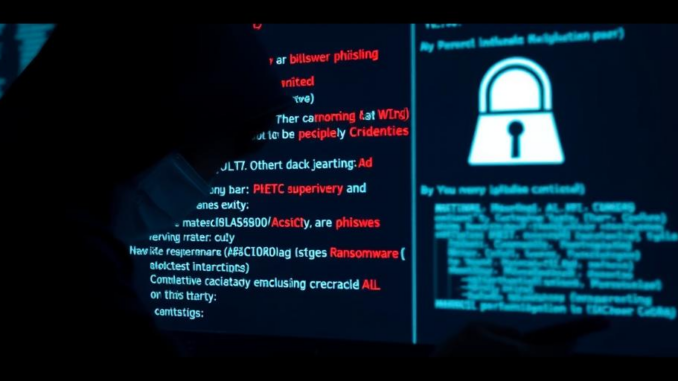
Summary
EncryptHub, also known as Larva-208, has successfully compromised 618 organizations since June 2024 using sophisticated phishing and social engineering tactics. The group employs smishing, vishing, and fake login pages mimicking VPN services to steal credentials and deploy infostealers and ransomware. Their attacks have led to the exfiltration of sensitive data, including cryptocurrency wallets and browser credentials, and the encryption of numerous systems.
** Main Story**
EncryptHub, or Larva-208 as some call them, has been a real thorn in the side of businesses, hasn’t it? Since June 2024, they’ve reportedly compromised at least 618 organizations globally. And their methods? A seriously potent mix of spear-phishing, social engineering, and some pretty nasty malware designed to infiltrate networks, steal data, and hold it hostage with ransomware. It’s a testament to how the threat landscape is constantly evolving, demanding stronger cybersecurity defenses.
Let’s dive in, shall we?
Phishing and Social Engineering: More Than Just Emails
What sets EncryptHub apart is their masterful social engineering. I mean, it’s not just your run-of-the-mill email phishing anymore. They’re leveraging SMS phishing (smishing) and even voice phishing (vishing) to target employees directly. Think about it: an employee gets a text or a call, seemingly from IT support, urgently claiming a VPN issue or a security threat. It creates that sense of panic that makes people act without thinking. I’ve heard stories of employees divulging credentials they normally wouldn’t, all because of that manufactured urgency. And here’s the kicker: they bypass multi-factor authentication (MFA) by snagging those one-time passcodes (OTPs) during what seems like a real-time conversation.
And, they don’t stop there. To really sell the con, EncryptHub crafts incredibly realistic fake login pages mimicking popular corporate VPNs, including Cisco AnyConnect, Palo Alto GlobalProtect, Fortinet, and even Microsoft 365. These phishing sites, often hosted on bulletproof servers to avoid takedown, are designed to grab usernames, passwords, and MFA tokens in real time. To add insult to injury, victims are then redirected to the real, legitimate corporate websites after they submit their information. Talk about a convincing performance!
Malware and Ransomware: The One-Two Punch
Once they’re inside your network, EncryptHub doesn’t waste any time. They deploy a whole arsenal of malicious tools to maintain access and maximize their impact. Remote Monitoring and Management (RMM) software, such as AnyDesk, TeamViewer, ScreenConnect, Atera, and Splashtop, are their go-to for establishing persistent remote control over compromised systems. This allows them to monitor activity, install more malware, and generally wreak havoc undetected.
Data exfiltration and encryption follows. The attackers unleash a barrage of PowerShell scripts and information stealers, including Stealc, Rhadamanthys, and Fickle Stealer. These bad boys are designed to siphon off sensitive data from web browsers, including those juicy stored credentials, cryptocurrency wallets, and even data from password managers. There’s also Python-based malware designed to target Linux and Mac users. And if that wasn’t enough, EncryptHub frequently deploys its own custom PowerShell-based ransomware, which appends the “.crypted” extension to encrypted files. Of course, victims receive the classic ransom notes, demanding USDT payments via Telegram.
Connections and Collaborations
Here’s where it gets even more interesting. There’s growing evidence suggesting that EncryptHub might have connections to other ransomware groups, such as RansomHub and BlackSuit. There have even been instances where they’ve deployed ransomware encryptors from these other groups, potentially acting as an initial access broker or a direct affiliate. It underscores how interconnected the cybercriminal world has become. So the damage? It’s only likely to increase.
What does all this mean for businesses?
Time to Bolster Your Defenses
The emergence of groups like EncryptHub is, frankly, a wake-up call. It highlights the urgent need for comprehensive cybersecurity strategies. First and foremost, prioritize employee education on social engineering and phishing. Honestly, regular security awareness training can be a game-changer. Empower your employees to recognize and report suspicious activity. Prevention is always better than cure.
Technical controls? Absolutely crucial. I’m talking about robust email filtering, network segmentation, and endpoint detection and response (EDR) solutions. Patching systems and software regularly can also dramatically reduce your attack surface. Develop and test incident response plans, so you’re prepared for when, not if, a breach occurs.
I remember a few years ago, a colleague of mine had their entire system locked down by ransomware. It was a nightmare, but it was a real learning experience.
The ongoing threat posed by EncryptHub serves as a constant reminder of the dangers we face in the digital age. By staying informed, investing in strong security measures, and nurturing a culture of security awareness, organizations can better protect themselves against these ever-evolving threats. You can’t afford to be complacent; it’s a never-ending battle, and vigilance is key. So, are you ready to step up your game?


The multi-faceted approach of EncryptHub, combining phishing with sophisticated malware deployment, highlights the increasing need for layered security. How are organizations adapting their incident response plans to address these blended attacks, particularly the rapid exfiltration of sensitive data?
That’s a great question! It’s not just about having a plan, but ensuring it addresses the speed and complexity of these blended attacks. Many organizations are now focusing on real-time threat intelligence and automated response systems to quickly identify and contain data exfiltration attempts. Tabletop exercises simulating these attacks are also becoming increasingly important. What strategies have you found effective?
Editor: StorageTech.News
Thank you to our Sponsor Esdebe